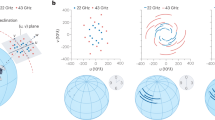Abstract
The National Radio Astronomy Observatory's proposed Millimeter Array (MMA) will bring unprecedented sensitivity, angular resolution, and image dynamic range to the millimeter wavelength region of the spectrum. An obvious question is whether such an instrument could be used to detect planets orbiting nearby stars. The techniques of aperture synthesis imaging developed for centimeter wavelength radio arrays are capable of producing images whose dynamic ranges greatly exceed the brightness ratio of a solar-type star and a Jupiter-like planet at sub-millimeter or millimeter wavelengths. The angular resolution required to separate a star and planet at a few pc distance can be obtained with baselines of several km. The greatest challenge is sensitivity. At the highest possible observing frequencies (∼ 300 GHz for typical high, dry sites, and ∼ 900 GHz from the Antarctic plateau), the proposed MMA will be unable to detect the thermal emission from a Jupiter-like planet a few pc away. An upgraded MMA operating near 300 GHz with twice the currently proposed number of antennas, a 20% fractional bandwidth, and improved receivers could detect Jupiter at 4 pc in a few months. Building such an array on the Antarctic plateau and operating at ≈ 900 GHz would allow Jupiter at 4 pc to be detected in approximately one day of observing time.
Similar content being viewed by others
References
Bally, J.: 1989, in: D.J. Mullan, M.A. Pomerantz and T. Stanev, ed(s).,Astrophysics in Antarctica, AIP Conf. Proc. 198, 100.
Burova, L.P.et al.: 1986,Soviet Astron. Lett. 12, 339.
Hughes, R.E.: 1990,The Millimeter Array, A Proposal to the National Science Foundation Submitted by Associated Universities, Inc., NRAO, 153.
Jones, D.L. and Diner, D.J.: 1989,Nature 337, 51.
Lynch, J.T.: 1989, in: D.J. Mullan, M.A. Pomerantz and T. Stanev, ed(s).,Astrophysics in Antarctica, AIP Conf. Proc. 198, 249.
Parish, T.R.: 1988,Rev. Geophys. 26, 169.
Pearson, T.J. and Readhead, A.C.S.: 1984, in: G. Burbidge, D. Layzer, and J. Phillips, ed(s).,Ann. Rev. Astron. Astrophys. 22, Annual Reviews: Palo Alto, 97.
Thompson, A.R., Moran, J.M. and Swenson, G.W.: 1986,Interferometry and Synthesis in Radio Astronomy, John Wiley & Sons: New York, 164.
Townes, C.H. and Melnick, G.: 1990,P.A.S.P. 102, 357.
Author information
Authors and Affiliations
Rights and permissions
About this article
Cite this article
Jones, D.L. Direct imaging of planetary systems with a ground-based radio telescope array. Astrophys Space Sci 212, 391–394 (1994). https://doi.org/10.1007/BF00984542
Issue Date:
DOI: https://doi.org/10.1007/BF00984542




